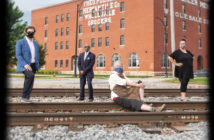| story by | |
| photos by | Steven Hertzog |
Infill development surges on the east side despite strict city codes and a lack of incentives for smaller projects.
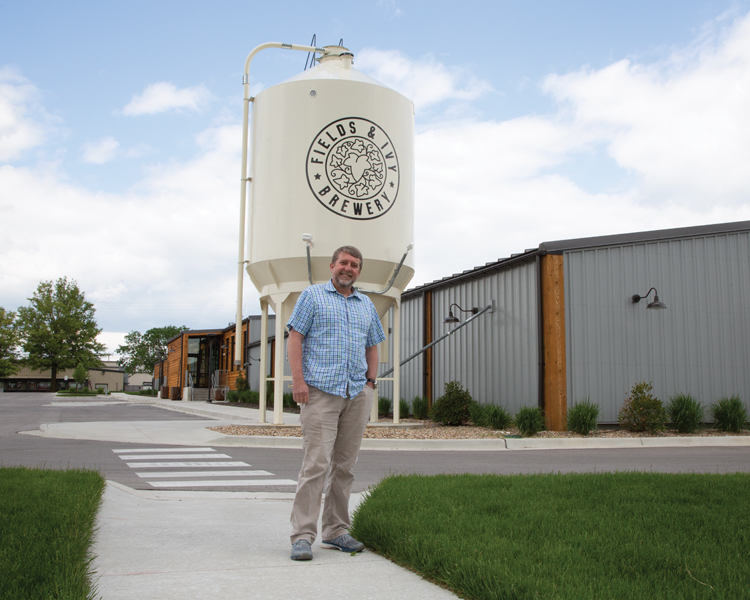
Cory Johnston in front of Fields & Ivy Brewery
In the past decade, infill development has taken off like wildfire in eastern Lawrence. Vacant lots and formerly empty, crumbling buildings have been replaced by bright new structures and creative remodels, both in commercial areas like the Warehouse Arts District and in residential areas such as the Brook Creek Neighborhood. The East 23rd Street corridor has redeveloped with a variety of businesses revamping older structures and filling in empty spots.
Almost 100 new residences have been built on vacant lots or knockdown properties north of 23rd Street in eastern Lawrence since 2010, with more slated or already under construction. Countless businesses—established and new—have relocated to, remodeled and expanded east of Massachusetts Street in the same time frame.
All of this infill development has taken place in spite of what many developers say is a lack of incentives for smaller-scale projects and rigid city codes that are both dated and antidensity. Indeed, according to the City of Lawrence 2019 Annual Economic Development Report, all of the Neighborhood Revitalization Areas in eastern Lawrence that received tax rebates in 2019 were large housing multiplexes or commercial offices. Also in the 2019 report, the city’s Property Tax Abatements for both its “Catalyst” and “non-Catalyst” programs were given to companies and organizations that have annual revenue in the multiple millions of dollars.
 We can build new housing while preserving the quality and character of adjacent residential districts and ensuring infill development strengthens the surrounding neighborhood.
We can build new housing while preserving the quality and character of adjacent residential districts and ensuring infill development strengthens the surrounding neighborhood. 
–Gavin Newsom
The Brook Creek Neighborhood was publicly divided in 2019 as residents and the City Neighborhood Association debated whether to diverge from the neighborhood’s previously zoned lot size to allow for additional housing to be built on vacant land and portions of oversized lots that were smaller than the city’s RS-7-zoned, 7,000-square-foot lots. Those spaces could provide what Tenants to Homeowners (TTH) executive director Rebecca Buford calls “bonus density” in the area and allow for more new affordable homes to be constructed. The rezoning was defeated after the brouhaha, but affordable housing and infill development proponents say the conversations likely will continue in order to find more opportunities for housing in desirable existing neighborhood locations.
Two Lawrence small businesses and one unique partnership are leading by example for smaller-scale developments with three different high-profile infill development projects in eastern Lawrence. One has been hit hard by the COVID-19 pandemic but has plans to bounce back, and the other two may find they are more necessary than ever because of the pandemic’s emergency and the hit to the local and national economy.
Sprucing Up
Anderson Rentals had been located at 1312 W. Sixth St. for about 40 years until the company relocated to the former Knights of Columbus hall, at 2206 E. 23rd St., in late spring.
Anderson Anderson says the company sold its Sixth Street building and land in 2016, and had been leasing it back until she and her brother, Bill, could find a suitable location with room to grow.
“We needed highway access and to be near residential areas. Sixth Street is full of student traffic, but on East 23rd Street, virtually everyone is going to or coming from work,” she explains.
Prior to the COVID-19 pandemic, the rental business already was expanding. Now, Anderson says, the business is even more poised to serve in its role as emergency response. They are looking at acquiring more decontamination equipment and trucks, and the new location has plenty of parking space and storage for that and more.
The Knights of Columbus building sat empty for about five years before Anderson Rentals moved there. The site also came with a large parking lot and clear, flat surrounding land, which is ideal for storing oversized equipment and outdoor implements, as well as providing loading and parking space for customers.
The building itself needed some adapting, but for the most part, its footprint has remained the same.
“The bones of the building were very good. We are doing a lot of accessibility stuff and converting it to a retail space, also putting in overhead doors,” Anderson says.
The timing of the move and the pandemic coincided in some challenging ways in terms of acquiring permits from the city and clearing the SBA (Small Business Administration) loan, and Anderson made several different contingency plans, which thankfully they didn’t have to use. Arriving to the location when demand for its services is at a high point helps make up for that. In fact, Anderson plans to hire at least three new people in 2020.
Anderson says she doesn’t see demand decreasing for the nonemergency side of the business, and the new location may even lure new customers who need tools for yard work and home improvements. The event business was down for the spring but will hopefully pick back up in summer and beyond.
“I have the best job. Everybody in the community comes in when they are building something, celebrating something or fixing something. It’s all about doing something,” she says.
Although there won’t be as much dancing in the building as there used to be, the former Knights of Columbus hall looks to be bustling in a new way.
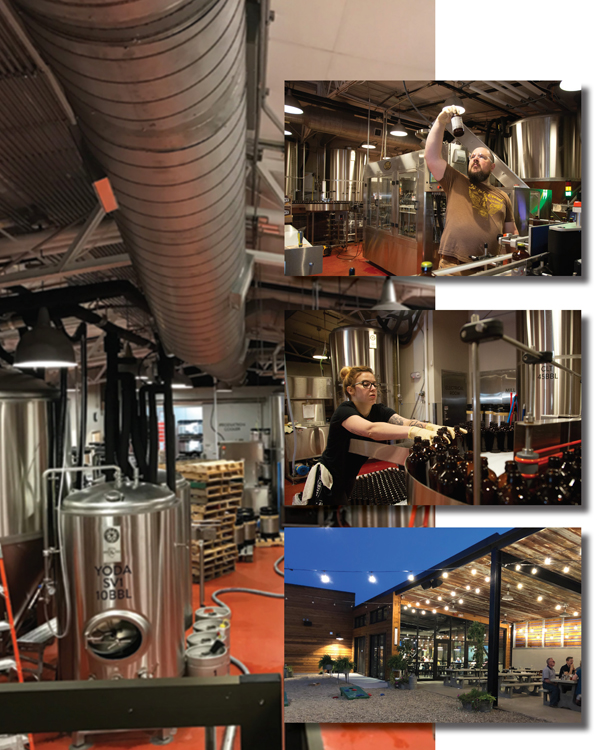
Fields & Ivy Brewery
Reinventing
Fields & Ivy Brewery, 706 E. 23rd St., turned a dilapidated lumberyard in eastern Lawrence into a restaurant with an on-site full brewery and outdoor beer garden. It opened for business in May 2019.
Owner Cory Johnston says the search for the best location spanned multiple counties over several years, and even then, equipment delays and other challenges forced changes to the eventual business model. As he and his partners scouted locales, he was open to rehabbing or redeveloping an existing site in order to infill and be in an established location.
“We always knew we wanted to be a packaging brewery, so we needed a good amount of square footage at a reasonable price. That was why we looked in Douglas County but not on Mass. Street,” Johnston says. “East 23rd Street met those criteria, with 25,000 cars per day. Plus, it’s a sweet retail location, so we decided to do a full kitchen and restaurant instead of just food trucks, as we’d originally planned.”
When the price dropped on the former lumberyard, Johnston knew he had the location he wanted, he explains. And having remodeled homes in the past, he had the vision to see past the land’s and building’s rundown conditions to visualize what it could become.
“It was a dump, no question about it. It had been vacant about eight years or so, and there was a homeless gentleman living in what is now the beer garden. Sabatini Architects helped with the vision, but it was a year of planning and me mowing the lot with my own mower before we started construction,” Johnston says.
Construction called for clearing some interior walls to create the taproom and for building drains and framing for the brewing production facility. Fortunately, he says, the former lumberyard awnings made for an ideal beer garden, with protection from rain and wind; so those original structures remain.
As if there hadn’t been enough challenges just to build and open Fields & Ivy, the business has lost about 80 percent of revenue this spring, despite having had curbside pickup service for both food and packaged beer during the COVID-19 epidemic. Johnston says he looks forward to the day the beer garden is packed with people again.
Although he is happy with Fields & Ivy’s ultimate location and facilities, he says he hopes the city will consider doing more to encourage businesses of his scale to infill develop.
“We had no tax relief or incentives, and we would have appreciated that. If the city wants 23rd Street to develop, they’re going to have to incentivize it. Small-business infill needs that, especially because infill doesn’t have to be industrial,” Johnston says.
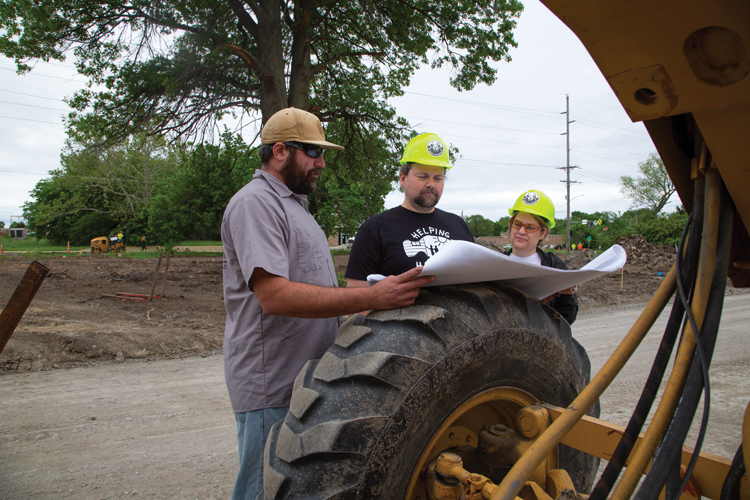

 Rebecca Buford, Landon Harness and Jeremi Lewis, TTH, Inc.’s General Contractor, look over plans for the Beatnick Court project at 19th and Bullene St.
Rebecca Buford, Landon Harness and Jeremi Lewis, TTH, Inc.’s General Contractor, look over plans for the Beatnick Court project at 19th and Bullene St.
Growing From the Ground Up
This spring, the Beatnik Court residential development in eastern Lawrence has broken ground—both literally and metaphorically. The development, near 19th and Bullene streets, comprises a cul-de-sac with 13 homes in a unique partnership between nonprofit Tenants to Homeowners and local home-remodeling and construction company Form & Function.
Seven of the homes will be affordable housing through TTH, selling in the $125,000 to $150,000 range for two- to three-bedroom houses. The other six will list for around $275,000, built by Form & Function. All homes are being designed by the same architect for a cohesive feel, says Buford, of Tenants to Homeowners. The name of the development, Beatnik Court, is a nod to late Lawrence resident and poet William S. Burroughs.
The land previously had a few houses that were in a state of disrepair. Landon Harness, owner of Form & Function, and his business partners purchased the land and worked with the city to make sure the zoning remained residential (it had been slated to change to commercial zoning in the city’s future planning). Those homes were knocked down to clear the land.
The most notable thing about the development is that TTH and Form & Function took the rezoning a rather drastic step further by establishing the lots as smaller than the city zones residential lots: 3,000 square feet instead of 5,000 square feet. By having the lots—and hence the homes—smaller, they can be priced more affordably.
Infill development has become a specialty of TTH, as it has built more than 40 affordable homes in eastern Lawrence in the past decade, many of which are in the Brook Creek neighborhood. Buford says TTH’s clients who purchase the homes are working people who have rented for years, and their salaries as baristas or social workers don’t allow them to accrue enough money for a down payment to purchase a home. Living in eastern Lawrence, because of infill construction, allows them either to be near downtown or to commute easily to Johnson County for work.
“The Beatnik Court location is great because of the access to the Burroughs Creek Trail for transportation or recreation,” she says. “I always ask, ‘What amenities are there for the neighborhood?’ They’re built in here: They can bike to work on the trail.”
Buford explains that in order for there to be more affordable housing and successful infill developments, nonprofits and for-profit businesses will need to continue to find ways to work together. She hopes that she and Harness are leading by example with Beatnik Court.
“I like infill development, because if we make cities more dense, we’ll see more vibrant districts and neighborhoods. Mixed-income development is good for everybody—it’s good for the people working their way up and good for the market value people,” Harness says.
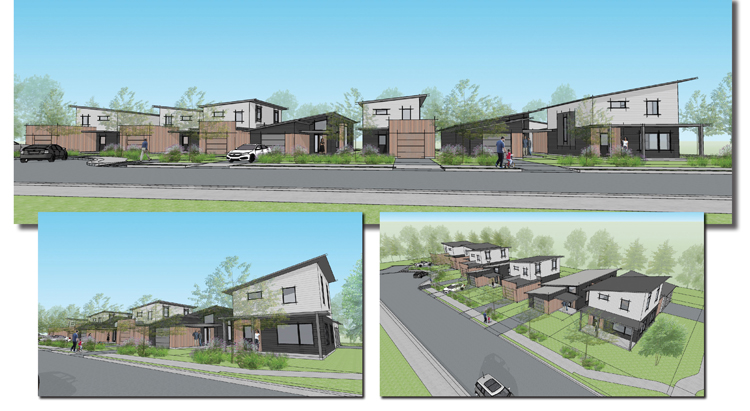
The Beatnik Court Concept Rendering. Courtesy of Hoke Ley, Architecture and Design
From the for-profit side, he says many city processes and codes work against developers doing smaller infill residential projects. The zoning change for Beatnik Court’s smaller residential lots took six months and cost $30,000 to get approved, he adds.
“I hope the city gets caught up on all of this, because it took a lot of effort. [City of Lawrence] Planning and Zoning need more flexibility on their end to interpret the rules—they are hamstrung by how the code is written. There are no variances from that for density,” he says.
The cul-de-sac and city services on the site have been underway since March and are led by Tim Keller, of RC Investment North. The lots are slated to close at the end of June, which was pushed back from the original close date in April because of the COVID-19 pandemic. Home construction will begin and likely proceed slower than planned because of possibly running into wintry weather with the timing change. Buford hopes to have all the TTH homes built by the end of 2021. Form & Function looks to be on a similar time line.
Both Buford and Harness emphasize that infill development and residential areas such as Beatnik Court benefit all of Lawrence, not just their immediate vicinities.
“If Lawrence wants to remain affordable, we have to get the most bang for our buck on land that’s inside the city limits,” Harness says.




